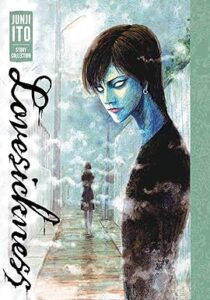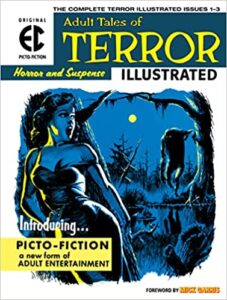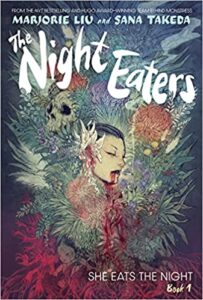Lovesickness: Junji Ito Story Collection by Junji Ito
Viz Media, 2021
ISBN: 9781974719846
Available: Hardcover, Kindle edition
Buy: Bookshop.org | Amazon.com
In Lovesickness, originally published in 1996 and told in 5 parts, Ryusuke Fukuda and his parents move back to the town of Nazumi after his father accepts a job there. The story opens with a teenage girl approaching the crossroads of an empty street where a man is emerging from the fog. She quickly places her notebook over her face and asks for a fortune. The older man responds and they part ways. When the man meets his family at the Nazumi train station, it is revealed that he is Ryusuke’s father. He relates the story to his wife and son, the latter shaken by the chance meeting.
When he starts at school the next day, he is greeted by an old friend, Midori. Eventually the topic of rumors comes up regarding teenage girls committing suicide after encountering a mysterious handsome young man. Ryusuke, in an attempt to calm his own guilty conscience when he reveals a terrible fortune he gave to a woman in distress, which led to a grisly suicide, hunts for the shadowy figure delivering his own tragic fortunes to innocent strangers at the crossroads.
The artwork in Lovesickness is probably some of my favorite in Ito’s work. The effect of the fog and shadows is excellent, and the body horror is fantastic. The handsome stranger is eerily beautiful. The character design reminds me of Fukusuke from the visual kei band Metronome.
Four other stories are included in this volume. “The Strange Hikizuri Siblings,” told in two parts, are a strange family, often at odds with each other while still trying to support each other the best they know how… to a degree. The first story, “Narumi’s Boyfriend”, shows the cruelty of the siblings and how they all take part in driving Kotani, the titular boyfriend, albeit in a forced relationship, to madness. In “The Séance”, we see family power dynamics play out in the worst possible way, with the two eldest brothers being just awful people.
The next story in the collection, “The Mansion of Phantom Pain”, relates the story of Kozeki, a young man employed to be a live-in caretaker for Yusuke, the son of a wealthy family. Yusuke’s condition is a strange phantom pain that extends beyond his normal body. A team of caretakers who can never leave the bricked up mansion manage the boy’s pain, day and night. When they start to experience their own maladies, and the death of Yusuke’s father, his mother still refuses to let them leave. Some of the caretakers slowly succumb to infections and hallucinations, but those remaining can’t leave, with the promise of the family’s wealth at stake, no matter how much Kozeki pleads for doctors.
Following that is “The Rib Woman”, a cautionary tale of rib removal surgery and obsession with the perfect figure. Yuki laments the lack of an hourglass figure like her friend Ruriko’s, and decides surgery is the best option. Throughout the story, Ruriko is tormented by strange and discordant music. One evening Yuki and her brother, who is also dating Ruriko, find the latter in agony on the sidewalk as she is trying to find the source of the song. They offer to help, and when they do find the source, they see a mysterious woman in the park playing a small instrument. She flees and leaves behind her instrument, which looks to be a large rib. After Yuki’s surgery, she too can hear the music. She also finds the woman and discovers there is more to the story than she believed. There is some deliciously good body horror in this one.
The final story in the collection is the inexplicable “Memories of Real Poop.” It’s the shortest chapter in this collection, at only four pages, but it’s memorable. I’ll just leave it at that. Highly recommended.
Reviewed by Lizzy Walker







Follow Us!